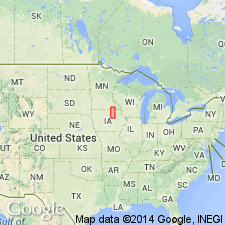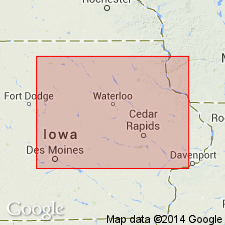
- Usage in publication:
-
- Andalusia Member
- Modifications:
-
- First used
- Dominant lithology:
-
- Dolomite
- Limestone
- AAPG geologic province:
-
- Iowa shelf
- Wisconsin arch
Summary:
Named as a member of the Lithograph City Formation (new) of Cedar Valley Group (rank raised) in southeast and east-central IA, Iowa shelf. Shares lateral facies relationship with the three northern members of Lithograph City Formation. Was formerly called "Upper Dolomitic Unit" by Witzke et al (1985). Is informally divided into two units--"lower" and "upper" Andalusia. Named after Andalusia Slough along the Mississippi River, in northwestern Rock Island Co, IL on the Wisconsin arch. Type section designated in NE NW NE sec 33, T77N, R2E, Scott Co, IA 1/2 mi north of the slough. At the type section consists of fossiliferous dolomites and dolomitic limestones and is 33 ft thick; shales are common in the lower 12 ft. Overlying and underlying units not stated. Is fossiliferous throughout, except for lower 30 cm, with brachiopods (listed), crinoids, bryozoans, gastropods, bivalves, rostroconchs, and nautiloids. Of Devonian age; Middle Devonian-Upper Devonian boundary lies somewhere in Lithograph City.
Source: GNU records (USGS DDS-6; Denver GNULEX).

- Usage in publication:
-
- Andalusia Member
- Modifications:
-
- Named
- Dominant lithology:
-
- Limestone
- Dolomite
- Shale
- AAPG geologic province:
-
- Iowa shelf
- Lincoln anticline
- Illinois basin
Summary:
Named as a member of Lithograph City Formation (named) of Cedar Valley Group (revised). Type locality is exposures at Buffalo Quarry, NW NW NE sec 33, T77N, R2E, 1.3 km north of Andalusia Slough in Mississippi River valley, Scott Co, IA. Present in southeast IA (Iowa shelf), and adjacent parts of northeast MO (Lincoln anticline) and western IL (Illinois basin). Same rocks formerly part of Coralville Member of Cedar Valley Formation, Lime Creek Formation, and Maple Hill Shale according to various authors. Considered to be a post-Coralville unit in this report. Characterized by argillaceous and fossiliferous dolomitic limestone, limestone with calcareous shale in lower part. Dolomite content increases upward. Coral and stromatoporoid biostromes in upper one-third in type. Hardground and discontinuity surfaces in member. Ranges from 6 to 12 m thick. Is about 6 m thick at type where it overlies Coralville Formation (revised) of Cedar Valley Group and underlies Sweetland Creek Shale. Is replaced by Osage Springs and Idlewild Members, both named, of Lithograph City to northwest. Fossils: conodonts of upper Lower ASYMMETRICUS Zone in upper part (Late Devonian, Frasnian), brachiopods, echinoderm debris, bryozoans, bivalves, gastropods, rostroconchs, nautiloids, fish debris. Spans Middle Devonian, late Givetian and Late Devonian. An open marine subtidal deposit. Nomenclature charts; graphic sections.
Source: GNU records (USGS DDS-6; Denver GNULEX).
For more information, please contact Nancy Stamm, Geologic Names Committee Secretary.
Asterisk (*) indicates published by U.S. Geological Survey authors.
"No current usage" (†) implies that a name has been abandoned or has fallen into disuse. Former usage and, if known, replacement name given in parentheses ( ).
Slash (/) indicates name conflicts with nomenclatural guidelines (CSN, 1933; ACSN, 1961, 1970; NACSN, 1983, 2005, 2021). May be explained within brackets ([ ]).

